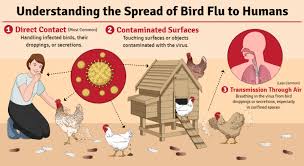Bird Flu: What You Need to Know
Most of us think of the flu as a seasonal nuisance, but some viruses pose far greater risks. Bird flu, or avian influenza, can jump from birds to humans, spreading quietly before causing severe complications. Understanding its dangers, how it spreads, and early warning signs can make a critical difference in staying safe.

Understanding Bird Flu
Bird flu primarily affects birds but can infect humans and other animals. Certain strains, like H5N1 and H7N9, are particularly dangerous to humans. Outbreaks can devastate the poultry industry and disrupt trade, highlighting the importance of public health awareness and preparedness.
How Bird Flu Spreads
The virus spreads mainly through contact with infected birds or their secretions — saliva, nasal fluids, and feces. Contaminated surfaces, cages, or tools can also carry it. While human-to-human transmission is rare, it can occur in close-contact settings. Migratory birds can spread the virus across regions, making strong biosecurity measures essential.
Recognizing Symptoms
Bird flu symptoms range from mild to severe and often resemble seasonal flu. The incubation period is usually 2–8 days. Key symptoms include:
Respiratory: Persistent cough, difficulty breathing, chest pain; severe cases may develop pneumonia or ARDS.
Gastrointestinal: Nausea, vomiting, diarrhea, abdominal pain; can lead to dehydration.
Neurological: Confusion, seizures, altered mental status; rare but serious.
Fever and Fatigue: High fever often with prolonged fatigue.
Muscle and Joint Pain: Mild to severe aches similar to seasonal flu.
Early recognition is critical for timely treatment and better outcomes.
Risk Factors
Those at higher risk include people in direct contact with birds, poultry farm workers, live bird market visitors, children, pregnant women, and individuals with weakened immune systems. Awareness of these risks allows for preventive action.
When to Seek Medical Care
Anyone with symptoms after exposure to birds should seek immediate medical attention. Severe respiratory distress, high fever, or neurological changes require urgent evaluation. Early treatment significantly improves recovery.
Preventive Measures
Preventing bird flu involves:
Practicing good hygiene and frequent handwashing
Using protective gear when handling birds
Vaccinating poultry and monitoring flocks
Avoiding contact with sick birds
Following public health guidelines and campaigns
Conclusion
Bird flu is a serious public health threat with the potential for severe illness and outbreaks. Recognizing symptoms, understanding transmission, and taking preventive steps are essential. Vigilance and preparedness can protect both individuals and communities from this ongoing global threat.
